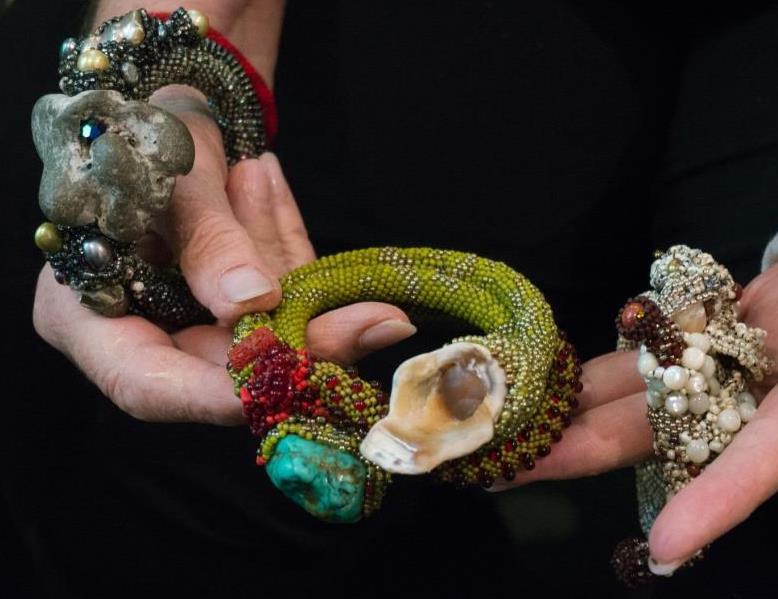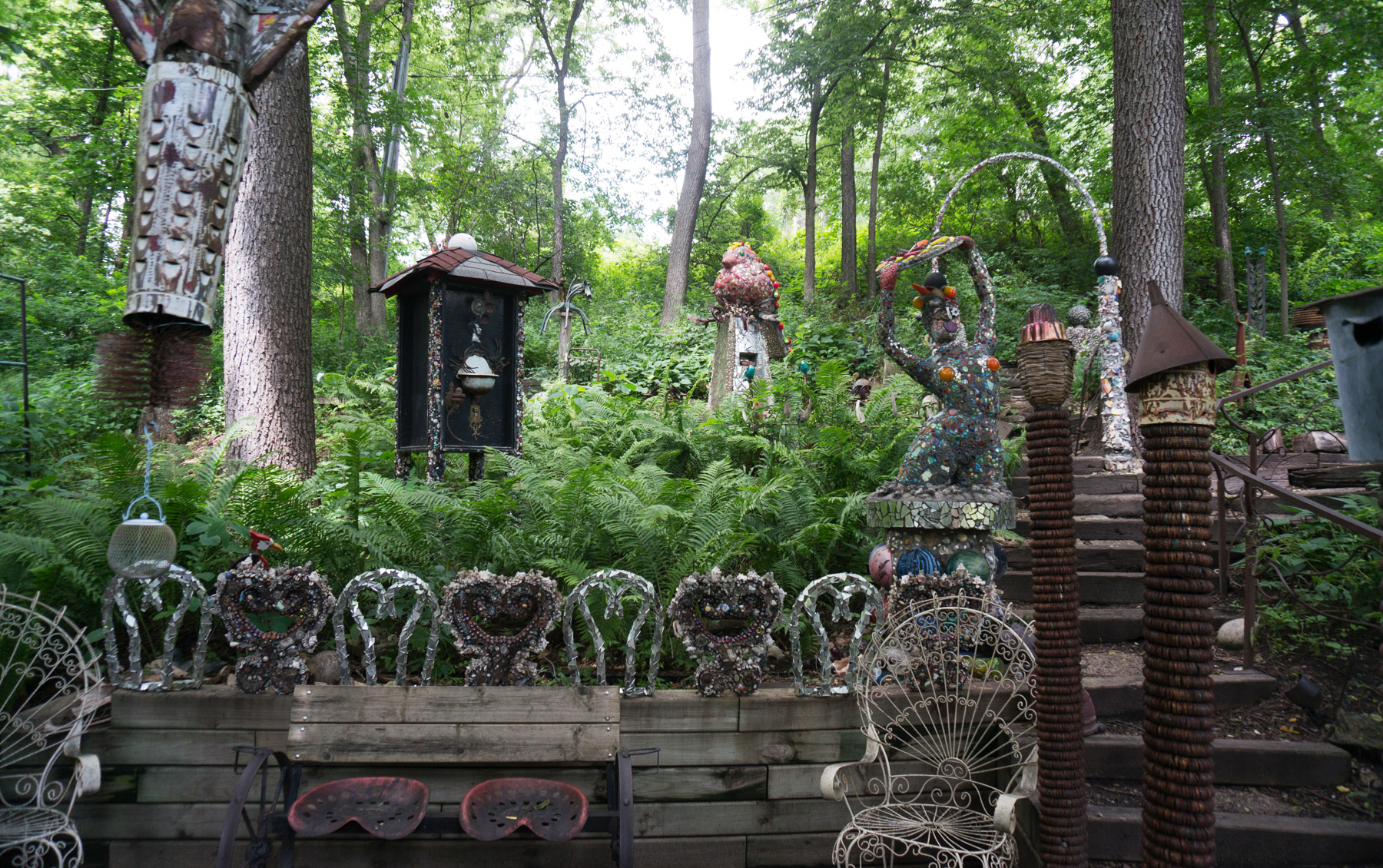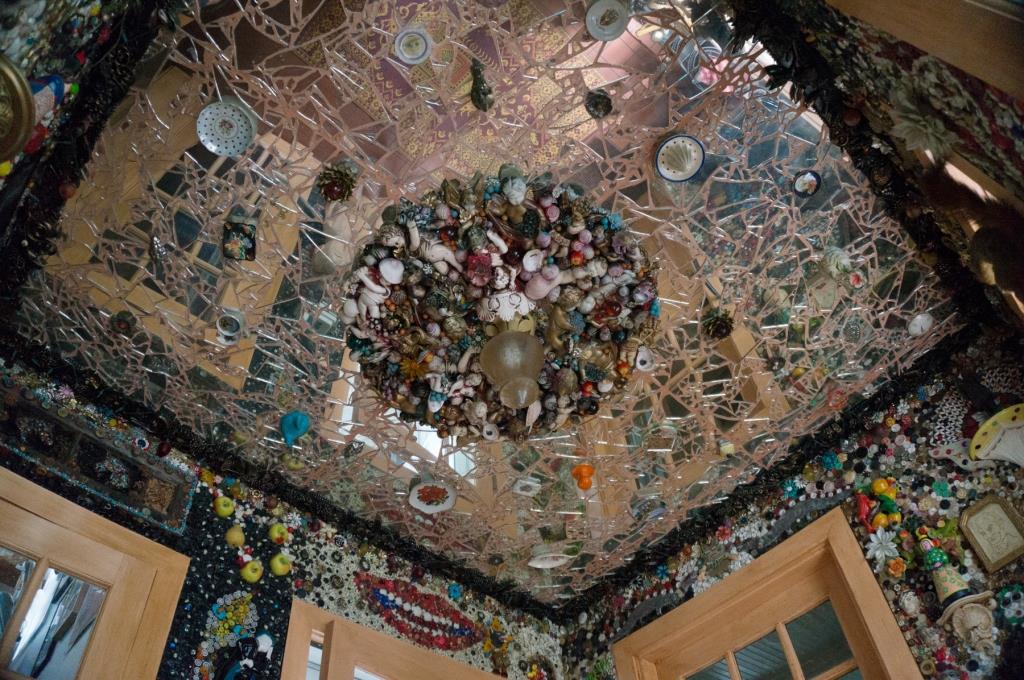A Perpetual Feedback Loop of Inspiration
Judy Onofrio's life's work defies easy categories, seamlessly blending art and craft, and the spheres of home, garden, and gallery. Here, she sits down with an emerging artist to talk about the art world, the vagaries of practice, and embracing fluid sources of inspiration

Judy Onofrio is a mixed-media sculptor who has been showing her work locally and nationally for more than 40 years. Earlier this summer, Onofrio graciously welcomed me to her garden, studio, and home in Rochester, where we talked about practice, inspiration, and the art world.
Onofrio’s mid-sized ceramic works in muted, neutral colors first drew attention in the early 1970s. That early work might surprise people more familiar with her large-scale, 3-D mosaic and mixed-media pieces made between 1990 and 2007. Since going through treatment for cancer, Onofrio has shifted her three-dimensional assemblage work again, using animal bones rather than colorful bric-a-brac. These most recent works have returned to the more muted color scheme and simpler forms of her early career. But through her more than four decades of prolific work, these sculptures, well recognized by museums, galleries, and collectors, have been only one aspect of Onofrio’s creative production. She also makes beaded jewelry, saying that it helps her relax while she watches TV at the end of the day. She says she made the mosaic sculptures, initially, for her own garden. Inspired by the outsider aesthetic of places like the Grotto of the Redemption in West Bend, Iowa, Judy adapted that style in her own back yard with the idea of “developing the space into outdoor living rooms, places to hang out.” Handmade metal railings and mosaic sculptures adorn and delineate these leafy social spaces.
The art world may distinguish between these practices, prizing her readily salable sculpture above jewelry and site-specific works made for the artist’s own home, but for Onofrio they are completely integrated. “It’s not separate at all – nothing is,” she says. “It’s all one deal.”
Onofrio has a strong affinity for outsider artists, but she doesn’t count herself among them. Instead, she identifies as “self-taught.” It’s a commonly used phrase, and I understand exactly what she means – i.e. that her art education was self-directed, informal, and non-academic. (I’d love it if the art world started using the term “informally educated,” a more accurate depiction of how one learns this business.) Like other “self-taught” artists I know, Onofrio sought out mentors and role models to learn from. She says, “I was just fortunate enough to have artists who have been willing to help me. I could go over and get a critique or get ideas about how to get my act together.” While inherent visual aptitude is undeniably important, you can’t discount the role of initiative and mentorship in this kind of education.

Onofrio continued to build community and create her own opportunities by way of working with the now-defunct Minnesota Crafts Council and Crafts Connection magazine, which she says were then “trying to get clay considered more seriously [with] exhibitions in museums and more important places… The old argument of whether it was craft or whether it was art was going on at that time.” She goes on, “[We] absolutely had successes. [These] were artists that I respected and have been friends with all these years. At that time there wasn’t anything [in terms of national opportunities]. Of course, right now there’s hardly anything either. But there was a time when a lot of the artists here were being shown nationally, were being connected up with more important venues.”
Onofrio’s 3D work in the garden eventually led to her shift away from clay in other areas of her practice. She found she enjoyed working with found objects so much that she began making sculptures in her studio using the same process. What followed, she says, was a tough decision; Onofrio recalls that making the sculptural assemblage works felt like “turning my back on clay.” She had already built a reputation, had gallery representation and a following. Perhaps more importantly, she was part of a regional and national community of ceramicists. But ultimately, Onofrio says, “what was most important was to do what I wanted to do.” As we talk, it’s clear that’s a throughline in her career. Onofrio plainly realizes the perspective of the art world very clearly, and she’s aware of how her work is valued through that lens, but she doesn’t really let it influence her, except perhaps when she’s actively worked to bring about changes (as with her efforts in the Minnesota Crafts Council). Speaking about her appreciation for outsider artists, Onofrio says, “I am really interested in people who just followed a path and went for broke.”
“If I’m out working in the garden, I’m constantly making aesthetic decisions and thinking about things that feed me when I come back in the studio.”
The same could be said for Onofrio herself. Talking to her, I am reminded that artists have been doing residencies in motherhood long before Lenka Clayton cleverly coined the term. Onofrio remembers: “I would have a big swimming pool in the basement and we’d mix clay with our feet. The kids were right in the middle of it in my clay studio.” She says she sees strong visual aptitude in all three of her children and vividly recalls the night she knew her daughter, Jennifer, (then in high school) was determined to be a professional artist herself:
“One night, I came home and the lights were on in the studio and Jennifer had done a piece on the wall. She had taken big slabs of paper… [had drawn on them,] and screwed them onto the wall with sheetrock screws right down the middle. I started crying and Jennifer said, ‘What are you crying for?’ It was knowing how hard she would have to work for the rest of her life to be able to do what she wanted to do. It just came on me at that moment. I’ve had a very golden life. I’ve had [my husband] Burton supporting me. [He] was a neurosurgeon and was gone 24/7, and I was totally free to do anything I wanted. He backed me up in any crazy thing I wanted to do. I knew Jennifer [might not have those advantages]; she was going to have a regular life.” Now Jennifer Onofrio Fornes, her daughter is indeed an accomplished artist in her own right and, Judy says, her mother’s best critic. Onofrio remains clear-eyed about the challenges of living as an artist, saying, “[Jennifer] called me a couple of years ago while she was doing a workshop somewhere and said ‘Now I know why you were crying.’”
From family and friends to personal projects, all of Judy’s endeavors nourish her various practices; she’s created a perpetual feedback loop of inspiration: “If I’m out working in the garden, I’m constantly making aesthetic decisions and thinking about things that feed me when I come back in the studio. Objects feed me.” I ask if living outside of a major metropolitan area has been isolating, but even as I say the words, I realize that Onofrio is too gregarious to be isolated. She’s just brought the artistic community to her. She and her husband, Burton, have supported the Rochester Art Center in many ways. “I would always back up the art center’s exhibitions with huge parties here at home. When I made friends, they were friends for life, and people just showed up. Our house was always open. I’ve never felt isolated at all. And if I [did], I would want to go to New York or Chicago and get some visual influx and then come home.”
Before we met, I had been thinking of her garden, house, and studio as private spaces, a kind of domestic practice separate from Onofrio’s professional career. But as our conversation progresses, I realize that, for her, these spheres aren’t distinct at all; they aren’t even really private. With the level of entertaining the Onofrios have done, many (often influential) people have had the opportunity to experience the interventions she has made in and for her home. I bring up the tradition of salons, women who convened gatherings of interesting people to discuss the latest ideas. Onofrio rejects the label but embraces the concept, saying “I didn’t think of it as ‘I’m having a salon,’ but I do love hanging out with my friends, sitting and talking about things that are meaningful to me.”

What’s striking about Onofrio, her work, and her worldview is that while her artwork is highly accomplished, both conceptually and formally, there’s a complete lack of pretense. She speaks very directly about who she is and what she does, which is unusual and refreshing. Onofrio’s work ethic outpaces that of almost anyone else I know. She admits, “I’m kind of a work-a-holic. I’m at it 24/7.”
She is also a mentally tough, resilient person. The financial freedom that comes from having a neurosurgeon husband helps, but I know enough about Onofrio to think that her self-described optimism is showing when she describes her life circumstances as “golden.” She’s faced chronic illness and a cancer diagnosis and kept working through it all. From acrobats performing daring feats that Onofrio herself is incapable of to the recent focus on bones as a material, her work reflects these painful corporeal experiences. Onofrio approaches it all with a glass-half-full mentality. On the day we talked, her broken left hand was in a cast. Onofrio noted that it affected her mobility and kept her from going out to gather animal bones from nearby farms, but while it heals, she says happily, “I’m just in [my studio], and can get everything done!”
Before interviewing Onofrio, I had preconceived ideas about how her work fit into an art historical context that includes Woman House and the Pattern and Decoration movement. After talking to her, though, I’m less interested in comparing and contrasting genres and more drawn to thinking about how her combination of work ethic, talent, opportunity, community, and stubborn commitment to her own unique vision have been crucial to her success. Now 75, she’s showing no signs of stopping. Primed sculptures hang on the wall of her studio, waiting for paint. There’s a new walkway carving its way around her house to the garden and growing sets of beaded bracelets. After all these years, her peyote stitch is so confident she no longer even looks at it while she works.
In the course of my own formal education, I’ve been to a lot of talks about how to sustain an artist career and practice. But, in the end, I didn’t ask Onofrio for specific advice. Her choices speak for themselves. My own takeaway for emerging artists: Don’t underestimate the importance of mentors. Find an artist you admire, give them a compelling reason to talk to you, and learn as much from them as you can while you have their ear.